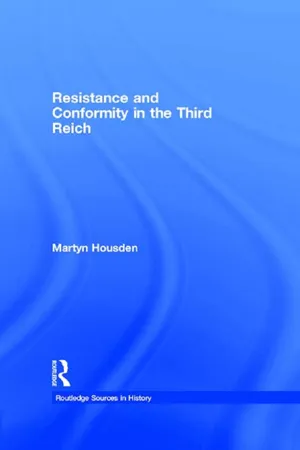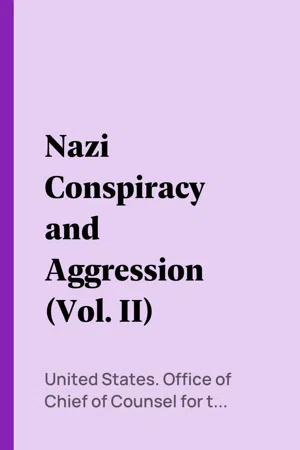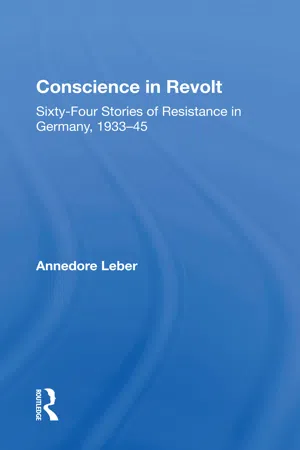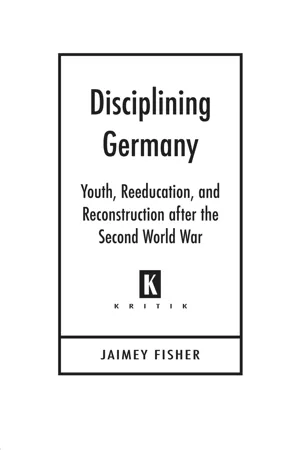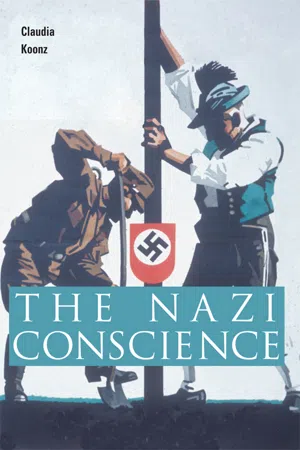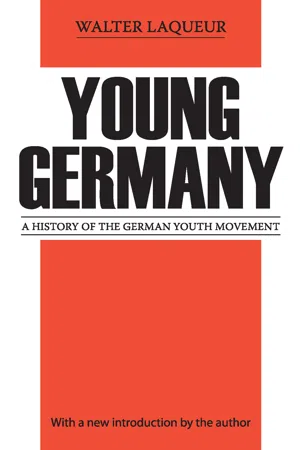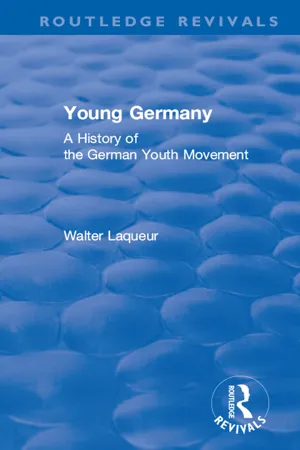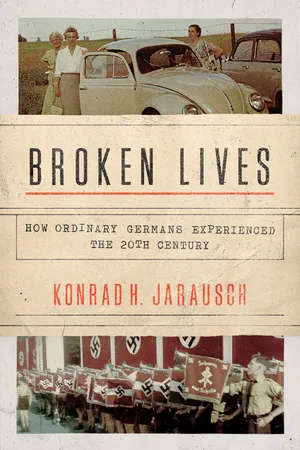History
Hitler Youth
The Hitler Youth was a Nazi youth organization in Germany, established to indoctrinate young people with Nazi ideology and prepare them for military service. It promoted loyalty to Adolf Hitler and the Nazi regime, emphasizing militarism, nationalism, and anti-Semitism. The organization played a significant role in shaping the beliefs and actions of German youth during the Nazi era.
Written by Perlego with AI-assistance
Related key terms
Related key terms
1 of 4
Related key terms
1 of 3
10 Key excerpts on "Hitler Youth"
- eBook - ePub
- Martyn Housden(Author)
- 2013(Publication Date)
- Routledge(Publisher)
Schörken, 1982, pp. 237–8). What is more, as historian Detlev Peukert has shown, the relationship between the state and young Germans changed fundamentally during the twelve years of Hitler's rule.Document 4.2 Three Phases
Those whose adolescence fell in the years 1933–6 had already had important, formative experiences before the Nazi seizure of power. They were in the front line for incorporation into the Hitler Youth [National Socialist youth organisation] and the so-called Volksgemeinschaft (racial community) of the Third Reich. They had also experienced the economic crisis of the early 1930s and were therefore quite receptive to the benefits offered by the rearmament programme (particularly after 1935–6), as well as to the ideas of the Führerstaat (leadership state), with its promise of an end to ‘party squabbles’, and of the ‘restoration of national greatness’.The young people of the period 1936–9 had no such memories. They had gone through schools that bore the stamp of National Socialism. For many, adolescence shaped by the Hitler Youth was something taken for granted and to which there was no alternative. Against group comradeship and leisure activities, occasional irritations in the form of brutality and intolerance, drill and demagogy, were often insignificant. And what is more, the Hitler Youth—as a rival to the traditional authorities of home and school—could to some extent serve as a ‘counter-authoritarian’ sanctuary. Involvement in its activities thus offered simultaneously the promise of making a name for oneself but also growing pressure towards uniformity. This latter feature grew stronger as the Hitler Youth became more bureaucratic, as its leadership corps grew older, and as the use of coercion to draw remaining young people into the organisation increased.The age group whose adolescence occurred during the war years 1939–45 experienced particularly the empty aspects of daily life in the Hitler Youth, characterised by coercion and drill. Quite a few youth leaders were conscripted into the army, and from 1942–3 onward many club buildings and sports fields were destroyed by the bombings. With this ‘war generation’ the grip of National Socialist institutions was simultaneously at its most far-reaching and increasingly repellent. - eBook - ePub
Hitler Youth
The Hitlerjugend in War and Peace 1933–45
- Brenda Ralph Lewis(Author)
- 2019(Publication Date)
- Amber Books Ltd(Publisher)
In 1934, which he termed ‘The Year of Training’, von Schirach expressed the principles by which unpromising material could be turned into reliable leaders in such a short time. ‘Whoever marches in the Hitler Youth is not a number among millions, but the soldier of an idea,’ he said. ‘The individual member’s value to the whole is determined by the degree to which he is permeated by the idea. The best Hitler Youth, irrespective of rank or office, is he who completely surrenders himself to the National Socialist world view’.TrainingA Hitler Youth was not intended merely as the ‘soldier of an idea’. He was always destined to fight real, hot war on behalf of the Third Reich. The emphasis on arduous physical activity, comradeship and blind devotion to the Führer was intended to harden young men for this purpose. However, as long as peace lasted, the battle to restore the name and reputation of Germany had to be fought in other ways. The Hitler Youth was set to learning trades, working on farms or in private homes, planting trees and flowers to beautify the parks, or rebuilding roads, singing in youth choirs and taking part in music festivals. Some of the boys concentrated on bettering the lives of rural children, who were relatively deprived in the 1930s compared to their town counterparts. For them, the Hitler Youth provided medical and dental care, hygiene facilities such as showers, and exercise programmes to build up their health and physique.Members of the marine Hitler Youth flank a Nazi swastika at the 8th Nazi Party Rally, 8–14 September 1936. From the podium, von Schirach addresses the crowd.The Hitler Youth were required to show a great deal more empathy with the countryside than the occasional rural excursion for hiking or sports or giving help to the disadvantaged. One of the most potent Nazi slogans, ‘Blut und Boden’ (‘Blood and Soil’), was a banner under which the Hitler Youth were supposed to lead a move away from the towns, with their artificial temptations, back to the rural life where the ‘noble peasant’ worked the soil in tune with nature. There, untainted by the metropolitan mixture of the towns where Jews congregated, the peasants preserved the racially pure ethos of Aryan superiority. - eBook - ePub
The Co-opting of Education by Extremist Factions
Professing Hate
- Sarah Gendron(Author)
- 2020(Publication Date)
- Routledge(Publisher)
60As Evans indicates, in 1936, the Hitler Youth organization was even given the role of an official educational institution, making it no longer under the direction of the Reich Interior Ministry.61 Like other educational institutions, it too was responsible for toeing the party line with respect to the teaching of racial purity. In the Handbook for Schooling Hitler Youth, “teachers” – youth leaders who were often youths themselves – were expected to engage their members in what is referred to as “defensive warfare against mind and blood contamination by the Jews,” because “wiping out the less worthy and select[ing] the best” was thought to be “the means of raising the racial values of [their] people.”62 Actual school teachers were expected to share their power with representatives of Hitler Youth – for “the school is education from above” while “the HJ [Hitler Jungend] that from below” – so as not to undermine their authority with the other children or incur their wrath:63The more frequently that teacher and youth leader discuss the problems of the youths entrusted to their care, the better it will be not only for the school but also for the youth organization… . The teacher must exercise a great deal of tact in order to find the right tone in dealing with [youth leaders]… . Here the teacher must always strive not to reduce unnecessarily the authority of a youth leader in front of his comrades … which frequently will lead only to the psychologically understandable consequence that the Hitler Youth will close ranks against the teacher.64 - eBook - ePub
- United States. Office of Chief of Counsel for the Prosecution of Axis Criminality(Author)
- 2017(Publication Date)
- Perlego(Publisher)
Schirach thus subscribed to the “racial-political task” of the NSDAP and extended his jurisdiction even beyond the border of the German Reich. His encouragement and approval of anti-Jewish terror by youth is discussed below.(6) Through the Hitler Youth, Schirach assisted the Nazi conspirators in developing leaders and members of the NSDAP and its affiliated organizations, including the SA and the SS. Sometime before the launching of aggressive wars, the Hitler Youth had become the principal source of zealous members for the NSDAP and its affiliated organizations. Orders of the Party Chancellery concerned with “successor problems” of the Party emphasize constant attention to Hitler Youth members as future Nazi leaders, thus attempting the perpetuation of the Nazi regime and Nazi ideology for the immediate future and even into future generations. Only Hitler Youth members who distinguished themselves were to be admitted to the Party. Nazi leaders were instructed to use “properly qualified full-time Hitler Youth leaders * * * for the continuation of their political work in the Party service,” so that a necessary succession of full-time leaders in the Leader Corps (Fuehrerkorps ) of the Party would be secured. (3348-PS )The Party manual also discusses the Hitler Youth as a recruitment agency for future Nazi leaders and members of affiliated organizations of the NSDAP:“To secure for the Party valuable and trained recruits for leadership, suitable Hitler Jugend boys of over 17 can be assigned for education and training to leaders from local unit leaders on upwards.”* * * * * *“Besides the above-mentioned conditions for selections in general, a process of elimination results from the fact that from youth on the German is cared for, guided, and educated by the Party. First they are assembled in the Young Folk [Jungvolk ] from which the young people are transferred into the HJ. The boy of the HJ enters the SA, the SS, the NSKK or the NSFK or participates in the work of the affiliated organizations of the Party. After labor and army service, he returns for service to the Party and its affiliates, respectively.” (2401-PS - eBook - ePub
Conscience In Revolt
Sixty-four Stories Of Resistance In Germany, 1933-45
- Annedore Leber(Author)
- 2021(Publication Date)
- Routledge(Publisher)
1 YOUTH DOI: 10.4324/9780429039027-1 G ERMAN YOUTH, the men and women who grew up after the 1914–1918 war, provided much of the enthusiasm and support which brought Hitler to power. Many of them first became politically conscious in the days of the Weimar Republic. This was a period when good intentions and great efforts at reconstruction, often unappreciated, failed to bring about economic stability and failed also to give young people a purpose in life or a loyalty to democratic society. Strong parties of both Right and Left attacked the foundations of the state. During the economic crisis of 1929–30 subversive activities increased alarmingly and inflation was let loose, working men brought home their wages in suitcases and university students queued up for the dole with millions of unemployed. The ground was well prepared for unscrupulous adventurers; and when the adventurers came, under the banner of a corrupted nationalism, it was above all the young who followed them into the darkest period of German history. These same men and women, and others who grew up later, also had to bear a very heavy share of the misery meted out by National Socialism. They had to kill for it and die for it and at the end even children, boys of 15 or 16, were put into uniform and sent out to stand between the Führer and his henchmen and the encircling armies, to delay by a few weeks or days or hours the inevitable retribution. But the young had to suffer far more than this: they grew up in an atmosphere of authority, fear, distortion, propaganda and hysteria; they were fed with false history and false ideology, and confused by callous invocation of freedom, patriotism and social justice; they were taught to despise individuality and to glory in the corporate bleating of the totalitarian state - eBook - ePub
Disciplining Germany
Youth, Reeducation, and Reconstruction after the Second World War
- Jaimey Fisher(Author)
- 2007(Publication Date)
- Wayne State University Press(Publisher)
Hitler Youth , which, although it effectively covers the institutional history of the Hitler Youth and incorporates more recent scholarship on the experiences of young people, still focuses on the youth group itself rather than its place either in the party hierarchy, the wider social context, or the cultural imaginary of Nazism in general. While I will give some background details on the institutions housing youth in the Nazi and postwar periods, I am primarily concerned with how discussion and debates about the “German youth” and the “younger generation” became, within (adult) culture in general, a key site on which to displace questions of the past and guilt for its crimes. Although I cannot hope to offer a full accounting of how young people facilitated the rise of the Nazi Party—a topic worthy of a much fuller study than I can offer herein—I shall demonstrate how at least certain sectors of Nazi culture imagined the Nazi revolution as a youth revolution. This imagined role of the young in remaking Germany provides important background for the rest of my study because it would prove remarkably influential in early postwar narrations of Nazism and, subsequently, in early postwar attempts to come to terms with the Nazi past.YOUTH , HITLER -JUGEND, AND THE NAZI MOVEMENTWhile Schirach suggests that he built up the Hitler-Jugend, it is closer to the truth to observe that he did not lay the necessary groundwork for the movement. This disjuncture reflects the complex relation between the youth group and the Nazi Party, which clouds the common assumption that the young were indispensable in the ascent of National Socialism. There is, in fact, significant scholarly disagreement on the importance of youth for the Nazi movement and for the regime. While most scholars seem to assume that youth played a pivotal role in the movement, scholars like Joachim Radku and Bernd Hüppauf have suggested that Nazism did not rest on the backs of the young as much as widely assumed.4 In fact, the early organizational and foundational institutional work was done not by members of Hitler’s inner circle like Schirach but by others, and the Hitler-Jugend had roots in the independent youth movement of the 1920s and even in the pre–World War I period, rather than in the Nazi Party. As was true of much of German society during these years, the changing character of the Hitler-Jugend—the name it was given only in 1926—reflected the increasing politicization of society during the Weimar period, during which the group was as much youth organization as party branch.5 - eBook - ePub
- Claudia Koonz(Author)
- 2005(Publication Date)
- Belknap Press(Publisher)
Ethnic fundamentalism was built on values that already enjoyed unquestioned support among patriotic teachers. The few who dissented were made to feel marginal to a great ethnic purpose—one to which an immense mass of like-minded ethnic citizens had subscribed and from which “unwanted” citizens had been expelled. Open criticism of specifically Nazi doctrine (such as the Führer cult, coarse antisemitism, opposition to Christianity) died out. But teachers discovered that as long as they avoided anti-Nazi remarks in class or in the presence of zealous colleagues, they could deemphasize parts of the curriculum they disliked and, if they had Jewish pupils in their class, shelter them in small ways from Hitler Youth harassment.This kind of selective compliance assuaged some of the pain suffered by many “unwanted” students at the hands of Nazi colleagues. But it did little to impede the Nazification of German youth because in 1936 all non-Nazi youth organizations were banned and in 1939 membership in Hitler Youth was required of all children with “appropriate” racial backgrounds. Within this vast organization, committed Nazi teachers had ample opportunities to initiate future citizens into the rigors of Nazi ideology: pagan rituals, ethnic arrogance and racist contempt, the Führer cult, and Germany’s right to Lebensraum . Young—presumably pro-Nazi—teachers were expected not only to join Nazi-affiliated organizations but also to guide Hitler Youth indoctrination.129 Twelve thousand males cooperated in this effort to shape boys “who were tough as leather, swift as greyhounds, hard as Krupps steel.” Seven thousand five hundred women teachers were charged with producing strong-minded girls who would bear the next generation. In addition to the immense Hitler Youth organization, Labor Service camps and the German Labor Front promoted Nazi ideology. For the students selected to become the elite of the future, the Nazi Party established a network of boarding schools which designed every facet of daily life so as to produce hardened young men prepared to sacrifice for theirVolk.130 - eBook - ePub
Young Germany
History of the German Youth Movement
- Walter Laqueur(Author)
- 2017(Publication Date)
- Routledge(Publisher)
Rolandbriefe in the Rhineland. Of the youth organizations grudgingly permitted a semi-legal existence, the Catholic groups were the only ones in which something of the spirit of the youth movement survived; they were kept under close surveillance and their activities restricted by special administrative measures. Certain Protestant groups also continued to be active, and took part in Boy Scout camps outside Germany.But the ‘Hitler Youth Law,’ which was promulgated on 1 December, 1936, put an end to the semi-legal status of confessional groups. Every boy and girl now had to belong to the State youth organization. One noteworthy consequence was that, whereas National Socialism had in previous years attacked the Bünde for their elitist practices, the Hitler Youth now found itself forced to assume a still more invidiously élitist structure. Its rank-and-file members, enrolled by legal obligation, were sharply differentiated from the ‘hard core’ of earlier adherents, the so-called Stamm Hitler Youth, who provided leaders for the mass organization.III
The Bünde had ceased to exist; but the Hitler Youth was imperfectly satisfied by its triumph. Elimination of its rivals by force of law was not enough; they must also be discredited ideologically, condemned before the bar of history so that their evil spirit could be exorcised for ever. Baldur von Schirach began his work on the youth movement with the words: ‘What was previously called the German youth movement is dead.’1 That was indisputable in 1934, but what was to be its place in history? Had it been a help or a hindrance to the resurrection of Germany under Adolf Hitler? His answer was that some of the ideas of the youth movement and a part of its way of life had influenced the Hitler Youth and been taken overby them2 —for instance, the idea that youth should be led by youth only, the rejection of the concepts of bourgeois society, the exaltation of comradeship, of defence of the homeland and the Volkstum. But beyond this their ideas were nebulous, their aims confused, and the best thing about the Hohe Meissner was not the speeches but the boys and girls listening to them. In the view of von Schirach and other National Socialist publicists, the youth movement had done good work up to the First World War, but had become a mainly destructive influence after 1918; the Bünde had all the weaknesses of the earlier Wandervogel without its merits. Most of their members had failed to recognize that a saviour had arisen in the person of Adolf Hitler; they had been weak and undecided; even those who accepted the basic truths of National Socialism had refused to draw the practical conclusions.1 Some of those aristocratic individualists had even professed sympathy with the ‘spiritual aims’ of National Socialism, and then said they did not think Hitler was the right man!2 - eBook - ePub
Routledge Revivals: Young Germany (1962)
A History of the German Youth Movement
- Walter Laqueur(Author)
- 2018(Publication Date)
- Routledge(Publisher)
PART FIVEPassage contains an image
IN HITLER’S SHADOW INineteenN ATIONAL Socialism came to power as the party of youth. Its cult of youth may have been less pronounced than that of Italian Facism, whose very hymn was called ‘Giovinezza’; but Hitler lost few opportunities of declaring that his movement was inter alia a revolt of the coming generation against all that was senile and rotten with decay. Yet for all their claims to represent youth, the National Socialists never succeeded in establishing a strong youth movement of their own before 1933. All through the twenties the Hitler Youth remained a negligible force, and in 1933, when it became part of the State apparatus, it lost whatever spontaneity or independence it may ever have had.The establishment of a separate youth group dates back to February 1922, when Hitler demanded this in a circular letter to his Party and in a manifesto published soon afterwards in its newspaper.1 The head of this initial group was a man named Lenk, who soon faded out of the picture—perhaps because he was charged with embezzlement. An interregnum followed, in which the Schill Youth, a right-wing extremist Bund, became for a time the official youth section of the party. Kurt Gruber, who was appointed to succeed Lenk, even announced in a letter to Rossbach, the former Free Corps leader, that he wanted to unite his own young Hitlerite groups in Saxony with the ‘Schill Youth;’1 apparently the National Socialists did not feel confident of an independent success in this field. Nor did the Hitler Youth make much headway under Gruber. As late as 1929, Baldur von Schirach, who had been very successful as a students’ leader and was later to become Gruber’s successor, told Rossbach that ‘the Hitler Youth is badly led and its discipline is indifferent.’2 To the leader of the Geusen, another extreme right-wing Bund, Schirach wrote that he was the friend of both the official party youth organization and the Geusen and that ‘the youth movement and the Hitler Youth cannot be divided.’3 - eBook - ePub
Broken Lives
How Ordinary Germans Experienced the 20th Century
- Konrad H. Jarausch(Author)
- 2018(Publication Date)
- Princeton University Press(Publisher)
71The memoirs show that it took exceptional insight and courage to remain aloof, refuse to comply, or actively resist the twisted universe of the Third Reich, since the sanctions were lethal. Among the nationalist elite, such as the Kleins, there was much “distance” from the plebeian Nazis, but “there was also closeness,” as many political goals overlapped. In democratic families, opposition was clearer, especially if they were Jewish like the Eycks or prominent-enough liberals to fear for their lives. In homes close to the Confessing Church such as the Helmers, the father was even forced to enter a psychiatric clinic in order to escape Nazi persecution. In Communist and Social Democratic circles, the brutality of the Gestapo was so malicious that resistance was the only possible recourse. But parental skepticism did not automatically inspire adolescents to oppose the regime; even critical youths like Gerhard Krapf felt “torn between sweeping enthusiasm and nagging doubt.”72Ultimately the Nazi youths were to suffer dearly for the blindness with which they followed the Führer into a war of annihilation and racial genocide. The combination of nationalist home, Nazified school, and Hitler Youth indoctrination made the majority obedient tools of Nazi repression and aggression. Agnes Moosmann blames “the deference to authority and lack of critical thinking” for the disaster. There were all too few democrats, Social Democrats, and Communists to stem the brown tide. Some opponents withdrew into inner emigration, others fled abroad, and still others were incarcerated, often in the KZ. Approximately half of the graduating classes of young men were killed in the fighting. The young women had to endure bombing raids, flight and expulsion, or mass rapes by the Red Army. It took these horrifying experiences of their own suffering to show the majority that they had worshiped a false idol. Only a minority of authors, such as Horst Grothus and Eva Peters, have been willing to confront their personal responsibility and commit themselves to doing active penance.73
Index pages curate the most relevant extracts from our library of academic textbooks. They’ve been created using an in-house natural language model (NLM), each adding context and meaning to key research topics.
Explore more topic indexes
Explore more topic indexes
1 of 6
Explore more topic indexes
1 of 4
